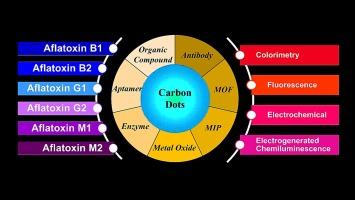Recent advances in detection of aflatoxins using carbon dots: A review
IF 4.9
2区 化学
Q1 CHEMISTRY, ANALYTICAL
引用次数: 0
Abstract
Aflatoxins are extremely harmful and cancer-causing substances generated by specific fungi that can contaminate various agricultural products, posing serious health risks to humans, food safety, and animals. Due to their high liposolubility, aflatoxins are readily absorbed into the bloodstream through the gastrointestinal and respiratory tracts. Given their resilience and widespread occurrence, aflatoxins continue to be a global concern, necessitating continuous monitoring and the development of innovative detection methods to protect public health and ensure food security. The emergence of carbon dots (CDs) presents a promising avenue for rapidly detecting aflatoxins. CDs offer numerous advantages, including negligible cytotoxicity, water solubility, biocompatibility, chemical stability, efficient light absorption, and exceptional photoinduced electron transfer. Despite these benefits the literature contains some novel reports on using CDs for aflatoxin detection, but lacks a review article. Therefore, this review article explores novel, and emerging detection methods for aflatoxins, such as colorimetric, fluorometric, electrochemical, and electrogenerated chemiluminescence techniques, focusing on the use of modified and unmodified CDs. It also demonstrates how multi-recognition elements are combined with CDs to improve selectivity, sensitivity, and stability for aflatoxin detection. Finally, challenges and limitations for future CDs implementation in real-world assays are discussed.

利用碳点检测黄曲霉毒素的最新进展:综述
黄曲霉毒素是由特定真菌产生的极为有害的致癌物质,可污染各种农产品,对人类健康、食品安全和动物造成严重危害。由于黄曲霉毒素具有很高的脂溶性,很容易通过胃肠道和呼吸道被人体吸收进入血液。鉴于黄曲霉毒素的顽强生命力和广泛存在,黄曲霉毒素仍然是一个全球关注的问题,因此有必要对其进行持续监测,并开发创新的检测方法,以保护公众健康和确保食品安全。碳点(CD)的出现为快速检测黄曲霉毒素提供了一条前景广阔的途径。碳点具有众多优点,包括可忽略的细胞毒性、水溶性、生物相容性、化学稳定性、高效的光吸收和出色的光诱导电子传递。尽管有这些优点,文献中仍有一些关于使用光盘检测黄曲霉毒素的新报道,但缺乏综述文章。因此,这篇综述文章探讨了新出现的黄曲霉毒素检测方法,如比色法、荧光法、电化学法和电致化学发光技术,重点介绍了改性和未改性光盘的使用。报告还展示了如何将多种识别元素与光盘相结合,以提高黄曲霉毒素检测的选择性、灵敏度和稳定性。最后,还讨论了未来在实际检测中使用光盘所面临的挑战和限制。
本文章由计算机程序翻译,如有差异,请以英文原文为准。
求助全文
约1分钟内获得全文
求助全文
来源期刊

Microchemical Journal
化学-分析化学
CiteScore
8.70
自引率
8.30%
发文量
1131
审稿时长
1.9 months
期刊介绍:
The Microchemical Journal is a peer reviewed journal devoted to all aspects and phases of analytical chemistry and chemical analysis. The Microchemical Journal publishes articles which are at the forefront of modern analytical chemistry and cover innovations in the techniques to the finest possible limits. This includes fundamental aspects, instrumentation, new developments, innovative and novel methods and applications including environmental and clinical field.
Traditional classical analytical methods such as spectrophotometry and titrimetry as well as established instrumentation methods such as flame and graphite furnace atomic absorption spectrometry, gas chromatography, and modified glassy or carbon electrode electrochemical methods will be considered, provided they show significant improvements and novelty compared to the established methods.
 求助内容:
求助内容: 应助结果提醒方式:
应助结果提醒方式:


